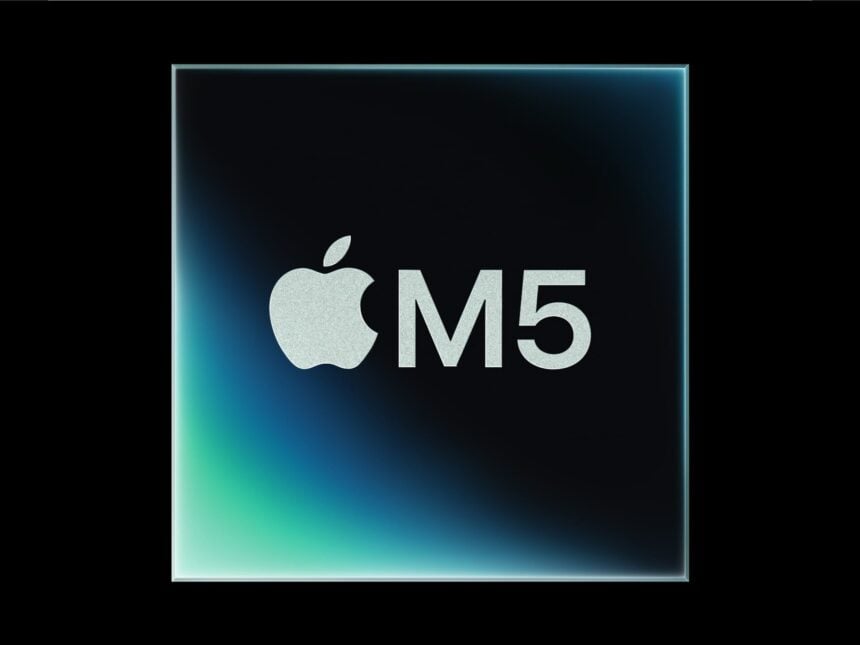Apple has announced M5, a new Apple silicon chip focused on AI workloads, graphics and memory bandwidth. The headliners: over 4x peak GPU compute for AI versus M4, a faster CPU, an upgraded 16-core Neural Engine and 153GB/s unified memory bandwidth.
The chip now powers the 14-inch MacBook Pro, iPad Pro and Apple Vision Pro, with pre-orders open today. If you care about running models locally, or you’re a creator who lives in Metal-based apps, this is the first proper generational jump since M1 set the tone.
What’s actually new in M5
Apple is pushing AI from every angle of the chip.
- 10-core GPU with a Neural Accelerator in each core
- Over 4x peak GPU compute for AI vs M4; up to 45% graphics uplift with third-gen ray tracing
- Up to 10-core CPU: four performance, six efficiency; up to 15% faster multithreaded
- Faster 16-core Neural Engine
- 153GB/s unified memory bandwidth (about 30% over M4)
The GPU change is the big one. Each core has its own Neural Accelerator, so AI inference no longer leans only on the Neural Engine. That means diffusion models, image generation and local LLMs can spread across GPU and Neural Engine, often finishing sooner with lower power draw. Apple also claims smoother gameplay and quicker renders via third-gen ray tracing plus reworked dynamic caching.
Real-world wins: creators, coders and model tinkerers
If you actually do things besides benchmarks, here’s where you feel it.
- Faster local image models in apps like Draw Things and better Core ML throughput
- Heavier Metal pipelines run faster; 3D apps see cleaner frame times
- On iPad Pro and MacBook Pro, bigger on-device models fit into memory without swapping
- Vision Pro gets a higher refresh ceiling and more pixels rendered for the micro-OLED panels
Creators get quicker preview-to-export loops and more stable playback in timelines. Developers running local LLMs or testing quantised models benefit from the extra GPU AI throughput and memory bandwidth. Vision Pro owners get a subtle but important display bump, which should reduce motion blur and help comfort during long sessions.
Devices getting M5, and the UAE context
Apple is rolling M5 into three product lines straight away.
- 14-inch MacBook Pro (M5): pre-orders are now live with prices starting at AED 6,899.
- iPad Pro (M5): pre-orders are now live, featuring faster AI capabilities and enhanced memory bandwidth to support heavier iPadOS workflows. Pricing starts at AED 4,199.
- Apple Vision Pro (M5): Apple has also confirmed a new Vision Pro with performance gains for spatial apps and higher display refresh rates that is priced at AED 13,999.
Related reads on Tbreak: our guide to the best iPad for the UAE in 2025 and how to choose a laptop for photo editing. These help map specs to real workflows.
How M5 changes Apple Intelligence on the device
Apple Intelligence leans on CPU, GPU and Neural Engine together, not just the Neural Engine.
- Higher memory bandwidth means larger context windows and bigger image models stay on device
- The faster Neural Engine accelerates Apple’s first-party features, such as Image Playground
- Developers using Foundation Models and Core ML should see immediate wins with Metal 4 and Tensor APIs
In practice, that should mean faster image creation, snappier summarisation and more consistent latency. If you’ve been hit by “model too big for memory” errors on older machines, M5’s 153GB/s and 32GB unified memory options will make those rarer. For more on recent Apple Intelligence coverage, see our iPhone round-ups: iPhone 17 in the UAE and iPhone 17 Pro.
Early benchmarks and availability
Apple’s own numbers cite up to 45% graphics gains vs M4 and 4x AI GPU compute. Third-party testing will take time, but the direction is clear: AI throughput and graphics matter more than raw CPU. Pre-orders are live today, with retail availability following shortly after, including in the UAE.
How much faster is M5 than M4?
Apple claims over 4x peak GPU compute for AI, up to 45% higher graphics performance and up to 15% faster multithreaded CPU performance versus M4. Real-world results will vary by app and model.
What’s special about Neural Accelerators inside the GPU?
Each GPU core includes a dedicated Neural Accelerator, so AI workloads can run across the GPU in parallel with the Neural Engine. That reduces bottlenecks and improves throughput for tasks like diffusion models and local LLMs.
Will Apple Intelligence run better on M5?
Yes. The faster Neural Engine and higher memory bandwidth help Apple Intelligence features respond quicker and keep more tasks on device. Developers using Apple’s Foundation Models framework should also see speed-ups.
When can I buy M5 devices in the UAE?
Pre-orders are open now with a shipping date of 22nd October. The Apple UAE site lists MacBook Pro from AED 6,899, with M5 configurations.
Is this upgrade worth it if I have M4?
If you run AI workloads, 3D or heavy Metal apps, the 4x AI GPU claim and 45% graphics bump make a stronger case. If your work is CPU-bound, M5’s gains are smaller but still meaningful. Waiting for independent tests is sensible.






















